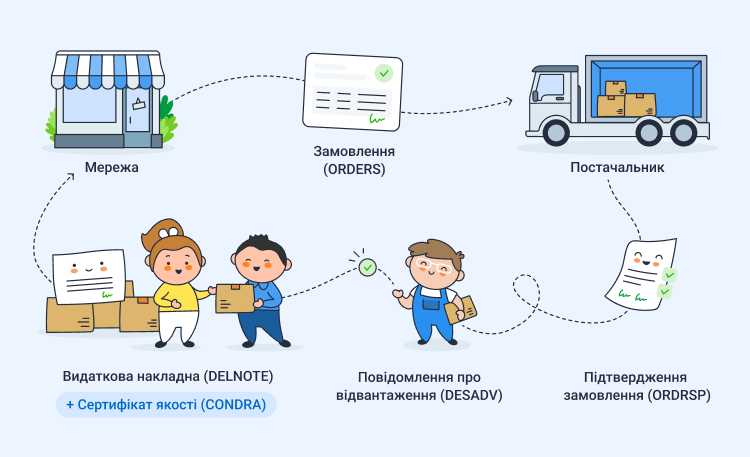In the daily work of retail chains and suppliers, there is a need to exchange documents that are not standard EDI documents, such as acts, certificates, consignment notes, etc. Previously, this was done via email or messengers. This created delays, errors, and confusion.
To make the exchange of such documents convenient, electronic document management systems use a separate message — CONDRA. In this article, we will analyze what it is, what business processes it is used in, and how to use it correctly.
What is CONDRA?
CONDRA (Drawing Administration Message) is one of the EDI messages defined by the EDIFACT standard. It is designed to transfer files in .pdf, .jpg, etc. formats. Such files are not standard EDI documents, but are important for trade business processes. In particular, using CONDRA, partners can send each other the following documents:
- invoices for payment;
- certificates of completion;
- quality certificates for goods;
- contracts and additional agreements;
- claims regarding quality, prices, shortages, etc.
Documents are sent and displayed as attachments to EDI messages. If necessary, they can be signed with an electronic signature directly in the EDI service. This gives the documents legal force. EDI services (such as Vchasno.EDI) allow you to sign documents in a single interface without switching between applications.
What problems in trade does CONDRA solve?
Prior to CONDRA, non-standard documents were exchanged through third-party channels such as e-mail, messengers, or other systems. This led to:
- delays in shipment and payment;
- risk of errors when documents were sent to the wrong counterparties;
- storage problems — it was difficult to find the right document among dozens of letters or paper archives.
With CONDRA, the manager sends the necessary documents linked to the right EDI message. This way, partners can see them in the supply chain structure and quickly assess whether all the requirements for the delivery documents have been met. The entire document flow during delivery is handled through the EDI service, so partners do not need to use third-party programs.

In EDI services, attached documents can be sent not only within the supply chain, but also as a separate message. This is how chains send contracts, additional agreements, penalties, calculations of bonuses and bonuses, and other documents required by business processes to suppliers.
How do retailers and suppliers use CONDRA?
Today CONDRA is a mandatory requirement of many retail chains for EDI providers. Suppliers who cooperate with these networks must also use it.
CONDRA helps to automate many business processes that have traditionally been used by large retail chains in their work with suppliers. Let’s take a look at the most common ones.
![]()
Confirmation of the quality of goods
Food chains often require quality certificates for products from suppliers. This allows them to control the quality of goods on the shelves.
The certificates that the supplier transmits in paper or sends by email are often lost. Even if the chain has received them, they are difficult to find when checking or making important deals. This leads to confusion, commercial losses, and fines. Therefore, the supplier attaches the certificate to the invoice, complying with the network’s requirements and making it easier for them to store and retrieve documents later.
![]()
Confirmation of payment for services
Networks pay suppliers for various services (logistics, marketing, etc.) provided over a certain period of time. According to the banks’ terms, payment can be received within 3-5 days, but the network must immediately confirm the payment. To do this, it sends a scanned copy of the payment confirmation via CONDRA.
![]()
Penalties for improper deliveries
Networks often send fines to suppliers for a certain period of time (e.g. monthly). CONDRA allows the network to send the supplier a penalty document, which both parties electronically sign to comply with legal requirements.
How are CONDRA documents stored?
All attachments sent via CONDRA to Vchasno.EDI are stored in a secure cloud archive. The documents are protected from any unauthorized access, and only authorized users have access to them. The document storage period is unlimited.
Vchasno.EDI users who have access to the archive can always view documents or sort them for quicker search. All documents in the archive have a processing status («Awaiting signature», «Signed by all», «Completed», etc.).
Conclusion
CONDRA significantly simplifies and automates the exchange of documents that were previously transferred manually or through third-party services. Suppliers and retailers can quickly exchange invoices, acts, quality certificates, contracts, and other important files.
This eliminates the delays and risk of errors that come with exchanging documents via email or messengers, allowing partners to quickly confirm the quality of goods, payment for services, fines, and other financial transactions.
Thanks to CONDRA, all necessary documents are linked to specific EDI messages, and business processes become transparent and controlled. All documents can be signed in a single interface with an electronic signature, which gives them legal force and eliminates the need to duplicate the exchange through other channels.






